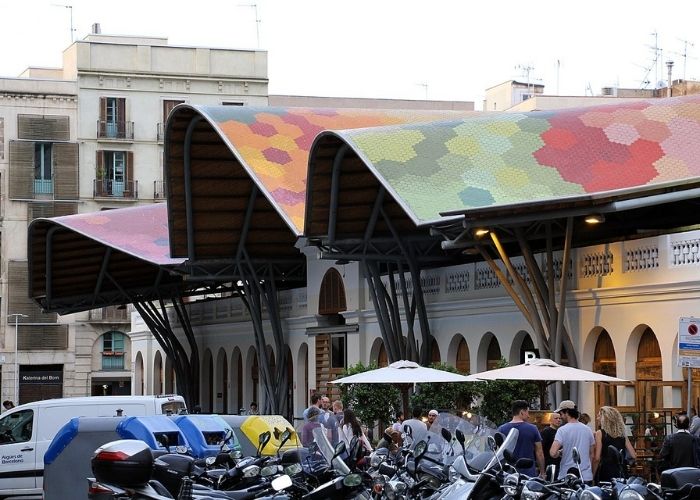Even if you are not hungry, the Spanish markets are a pleasure to walk around. However, they are not just markets; they are gastronomic temples where locals and tourists alike love to spend their time. In this overview, you will find ten beautiful covered markets in Spain.
According to chefs, the real beauty of the market lies in the history and in the artisans, and what’s more, the food chain – the gems of gastronomy – is created in the market. It is precisely for this reason that the Spanish newspaper Eldiario.es has devoted an article to the ten most beautiful markets in Spain. Markets that stand out for their architectural beauty and the offer presented.
Mercat de Santa Caterina (Barcelona)
It is the first covered market in Barcelona which was built in 1848. In 2005, this place in the El Borne district has got a wavy and colorful roof. Santa Caterina used to be a monastery but turned out to be a market where some restaurants have now been established.
Mercado de San Miguel (Madrid)
The iron construction and the ceramic and glass roof that illuminate the Plaza de San Miguel immediately catch the eye when visiting this covered market. At the beginning of 1916, foodstuffs were already being sold, but now it is a gastronomic temple where many different regional products can be tasted and bought.
Mercado de la Esperanza (Santander)
Since 1904, this covered market in Santander has undergone some renovations, but the original elements have always been preserved. Cheese and mainly fish are the main products sold in more than eighty stalls.
Mercat de Colón (Valencia)
The building was designed and built between 1914 and 1916 by the architect Francisco Mora Berenguer. It is one of the best examples of Valencia’s modernist architecture from the early 20th century and is also a national monument. The building has recently been renovated and you will find many stalls and catering facilities here.
Mercado de Abastos (Zamora)
At the beginning of the 20th century, this covered market was mainly made of iron and brick. The colored windows illuminate the stalls that settled here more than 100 years ago and supply the city. The market is located at Plaza Mercado 8 but will move to Parque de la Marina in a few months until the renovation is completed in 2024.
Mercado de Nuestra Senora de África (Tenerife)
Among the locals, this market is often referred to as La Recova. Here you can not only buy the traditional products of the Canary Islands, thanks to the gastronomic offer you can also taste and enjoy them directly. In this neoclassical building, more than two hundred merchants sell their products spread over two floors. There is a playground for the kids and various events are often organized.
La Ribera Gastro Plaza (Bilbao)
The market was built in 1928 and is located on the bank of the Nervión River next to the Casco Viejo. The commercial area covers 10,000 square metres, making this place the largest covered market in Europe. Many stalls can be found here, mainly full of fresh foods.
Mercado Público de la Unión (Murcia)
In 1907, the modernist building was built in the centre of La Unión in Murcia. The main facade with the clock and the Gothic and Romanesque details ensured that the building was declared a Cultural National Heritage of Spain in 1975. However, the building no longer functions as a market. However, various events are organized under the umbrella, such as the international festival Cante de las Minas.
Mercat de Sant Antoni (Barcelona)
This is one of the largest and most important markets of the Catalan capital. In fact, it consists of three types of markets: fresh food, clothing and the Sunday market, which mainly sells books. The building was inaugurated in 1882 and was designed by the architect Antoni Rovira i Trías. It was the first market to be built outside the city center.
Mercat Central (Valencia)
The design and construction of this covered market in Valencia took quite a while. Between 1839 and 1928, the aim was to create an architectural masterpiece that later became ‘the cathedral of the senses’.


